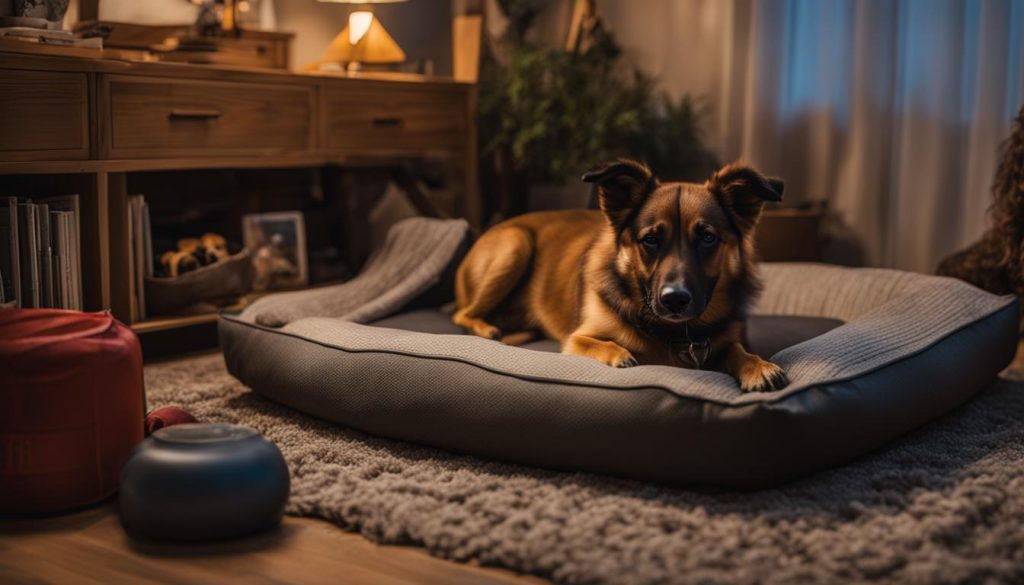Training your dog to sleep in his own bed is an essential aspect of dog training and behavior management. If you prefer not to have your furry friend on your furniture or sleeping in your bed, teaching him to sleep in his own designated space is crucial. In this article, I will provide you with effective methods to train your dog to sleep in his bed and establish a peaceful sleep routine.
Key Takeaways:
- Invest in a comfortable and cozy dog bed to ensure your dog sleeps well.
- Create a familiar environment in the bed by adding your dog’s favorite toys or blanket.
- Train your dog in a different room to help him transition from your bed to his.
- Establish a “go to bed” command and be consistent with its use.
- Reward your dog for good behavior and encourage him to go to his bed.
Invest in a Comfy Bed for Your Dog
When it comes to teaching your dog to sleep in his bed, one of the most important factors is providing him with a comfortable and cozy space to rest. Investing in a high-quality dog bed is essential for ensuring that your furry friend gets a good night’s sleep.
When choosing a dog bed, consider factors such as design, size, material, and comfort. Opt for a bed that is specifically designed for dogs, with features that cater to their needs. For instance, a memory foam bed or an orthopedic bed can provide extra support and relieve pressure points, making it ideal for older dogs or those with joint issues.
Additionally, pay attention to the size of the bed. It should be spacious enough for your dog to stretch out comfortably. If your dog likes to curl up, a smaller bed with raised sides may be more suitable. The material of the bed should be durable and easy to clean, ensuring that it can withstand regular use and accidents.

Table: Comparison of Different Dog Bed Options
| Bed Type | Features |
|---|---|
| Memory Foam Bed | Provides excellent support and comfort |
| Orthopedic Bed | Ideal for dogs with joint issues |
| Plush Bed | Soft and cozy material |
| Elevated Bed | Keeps your dog cool and off the ground |
To put it simply, your dog’s bed is his sanctuary, so choose one that meets his needs and preferences. By investing in a comfy bed, you are not only encouraging him to sleep in his own space but also ensuring his overall well-being and comfort.
Create a Familiar Environment in the Bed
To ensure that your dog feels comfortable and secure in his bed, create a familiar environment. One way to do this is by adding his favorite toys, blanket, or plushie to the bed. These familiar items will provide a sense of comfort and familiarity for your dog, making him more likely to choose his bed as a sleeping spot.
In addition to toys and blankets, you can also add a scent that your dog associates with relaxation. Rub your hands on the blanket or toy before placing it in the bed, or consider using a calming scent spray designed specifically for dogs. This will help create a soothing atmosphere in the bed, making it a more inviting space for your furry friend.
Another way to make the bed more appealing is by adding something with your own scent. This could be an old t-shirt or pillowcase that you’ve used, as your scent will provide a sense of familiarity and comfort for your dog. Just be sure to use items that you don’t mind being in your dog’s bed.

Train in a Different Room
When teaching your dog to sleep in his bed, you should train him in a different room than your bedroom. This helps to prevent him from automatically jumping on your bed and reinforces the idea that his bed is his designated sleeping area.
Consider using a guest room or the living room as the training location. These rooms provide a transition from your bedroom and create a distinct space for your dog’s bed. By training in a different room, you are helping your dog understand that his bed is a separate space from yours.
This training location shift can be particularly beneficial if your dog has a strong association with your bed and finds it difficult to stay in his own bed. By removing the proximity to your bed, you are helping him break that habit and establish a new routine.
Benefits of Training in a Different Room
Training your dog in a different room offers several advantages. Firstly, it helps to create a clear distinction between your bed and his bed, reducing the likelihood of him trying to sleep on your furniture. Additionally, it allows you to establish boundaries and reinforce the idea that his bed is his safe and comfortable space.
The change in environment can also help your dog feel more comfortable in his bed. Without the distractions and associations of your bedroom, he can focus on settling into his new sleeping area. Training in a different room provides a fresh start and an opportunity for your dog to form positive associations with his bed.
| Training Location | Benefits |
|---|---|
| Guest Room | Creates a separate space for your dog’s bed |
| Living Room | Provides a transition from your bedroom |
To put it simply, consistency is key when training your dog to sleep in his bed. By establishing a new location for training, you are setting the stage for success and helping your dog develop healthy sleeping habits.
Establish a “Go to Bed” Command
One of the key steps in teaching your dog to sleep in his bed is establishing a “go to bed” command. This command will cue your dog to go to his designated sleeping area on command. Consistency is key when training your dog, so be sure to use the same phrase every time you want him to go to his bed. For example, you can say “go to bed” or “bedtime” to signal to your dog that it’s time to sleep in his own space.
To effectively teach the “go to bed” command, start by using positive reinforcement. When your dog responds to the command and goes to his bed, reward him with treats or praise. This will create a positive association with going to his bed and encourage him to do it willingly.
Try to be patient with your dog during the training process. It may take some time for him to fully understand and obey the “go to bed” command. Consistency is key, so continue practicing the command regularly until your dog consistently follows the cue.
Benefits of the “Go to Bed” Command
The “go to bed” command serves several purposes in addition to teaching your dog to sleep in his bed. It can be used as a tool for managing your dog’s behavior in various situations. For example, if you have guests over or need your dog to be in a specific area, the “go to bed” command can help you guide him to the desired location.
Additionally, the “go to bed” command can provide your dog with a sense of security and routine. Dogs thrive on structure and consistency, and having a designated sleeping area can help them feel more secure and settled. By using the “go to bed” command consistently, you are setting clear boundaries and expectations for your dog, which can contribute to a well-behaved and happy pet.
| Benefits of the “Go to Bed” Command |
|---|
| Teaches your dog to sleep in his bed |
| Can be used to manage your dog’s behavior in various situations |
| Provides your dog with a sense of security and routine |
| Contributes to a well-behaved and happy pet |

By establishing a “go to bed” command, you can train your dog to sleep in his bed and create a peaceful bedtime routine. Try to be patient, consistent, and use positive reinforcement to encourage your dog’s cooperation.
Reward Good Behavior
Positive reinforcement is a key component of effective dog bed training. By rewarding your dog’s good behavior, you can encourage him to choose his bed over other sleeping areas. Treats and dental chews are great incentives to motivate your furry friend. When your dog willingly goes to his bed without being commanded, praise him and offer his favorite treats as a reward.
By associating his bed with positive experiences and rewards, your dog will learn to view his bed as a desirable place to sleep. This will help him develop a preference for his own bed and reduce the likelihood of him seeking out alternative sleeping spots.
Try to be consistent with the rewards and timing. I recommend that you reward your dog immediately after he demonstrates the desired behavior of going to his bed. This will help reinforce the connection between the action and the reward, making it more likely for your dog to repeat the behavior in the future.
| Reward | Description | Benefits |
|---|---|---|
| Treats | Small, bite-sized treats that your dog loves | Immediate and tasty reward |
| Dental chews | Chews designed to promote dental health | Keeps your dog’s teeth clean |
Rewarding your dog’s good behavior during bed training is crucial. By using positive reinforcement and offering rewards like treats and dental chews, you can motivate your dog to choose his bed over other sleeping areas. Be consistent with the rewards and timing to reinforce the desired behavior.
Be Patient and Consistent
When it comes to training your dog to sleep in his bed, patience and consistency are key. Dogs are creatures of habit, and it may take time for them to adjust to a new sleeping routine. Therefore, maintain a calm and patient demeanor throughout the training process.
Consistency is also crucial in reinforcing the desired behavior. Make sure to use the same command or cue every time you want your dog to go to his bed. This will help him understand what is expected of him and reinforce the association between the command and the action.
I recommend that you remember that every dog is different, and some may take longer to adjust to sleeping in their own bed. Don’t get discouraged if your dog doesn’t immediately take to his new sleeping spot. Instead, continue to be patient and consistent with your training efforts.
By providing your dog with a comfortable and familiar sleeping environment, using positive reinforcement, and staying patient and consistent, you can successfully teach your dog to sleep in his bed. To put it simply, Rome wasn’t built in a day, and neither is a well-trained dog!

Benefits of Patience and Consistency:
- Builds trust and strengthens the bond between you and your dog
- Helps your dog feel safe and secure in his own space
- Encourages positive behavior and reduces anxiety
- Establishes a peaceful bedtime routine for both you and your furry friend
Understand Your Dog’s Sleeping Habits

When training your dog to sleep in his bed, consider his unique sleeping habits. Understanding these habits can help you choose the right bed and create a comfortable environment for your furry friend. Whether you have a small dog or a large dog, taking their sleeping preferences into account will ensure a restful night’s sleep.
“A dog’s sleeping habits can vary based on their breed, size, and age,” says dog trainer Sarah Johnson. “Some dogs prefer to curl up in a cozy nest-like bed, while others like to stretch out on a spacious surface.”
For small dogs, a bed with raised sides can provide a sense of security and warmth. They may also appreciate a bed that is smaller in size, creating a snug and comforting sleeping space. On the other hand, larger dogs may require a bigger bed that accommodates their size and allows them to fully stretch out. Consider purchasing a memory foam mattress for your older dog, as it provides extra support and comfort for their joints.
| Dog Size | Bed Type |
|---|---|
| Small | Bed with raised sides |
| Large | Spacious bed |
| Older | Memory foam mattress |
By understanding your dog’s sleeping habits and providing a bed that caters to their specific needs, you can ensure they have a comfortable and restorative sleep every night.
Find the Right Spot for the Bed
When teaching your dog to sleep in his own bed, find the right spot for his bed. The location can greatly impact his comfort and willingness to sleep in it. Consider placing the bed in your bedroom, close to your own bed.
This proximity provides a sense of safety for your dog, as he can see and hear you during the night. It also allows you to keep an eye on him and easily check on his well-being. However, be mindful of the space available in your bedroom and ensure that the bed doesn’t obstruct your movement.
Additionally, make sure the placement of the bed is in a secure and comfortable area. Avoid placing it near doors or windows where drafts may disturb your dog’s sleep. Choose a spot where he feels safe and relaxed, away from loud noises or high-traffic areas of your home.
“Choosing the right spot for your dog’s bed is crucial for his comfort and sleep quality.”
To put it simply, dogs are creatures of habit, and establishing a consistent sleeping routine can help them feel more secure and relaxed. By finding the right spot for your dog’s bed, you’re providing him with a designated space where he can rest peacefully and develop healthy sleeping habits.

Repetition and Comfort
When it comes to training your dog to sleep in his bed, repetition is key. Consistently reinforcing the desired behavior will help your furry friend understand and adjust to his sleeping routine. To put it simply, dogs thrive on routine, so incorporating repetition into the training process will make it easier for them to learn and adapt.
During the training duration, make your dog’s bed as comfortable as possible. Choose a bed that suits his size and sleeping habits, whether he prefers a cozy nest or a spacious memory foam mattress. Providing a comfortable sleeping environment will encourage your dog to enjoy his own bed and discourage him from seeking alternative sleeping spots.
Additionally, consider incorporating comforting elements into your dog’s bed. Place his favorite toys, a soft blanket, or an item with your scent to create a familiar and calming space for him. These comforting items will help him feel secure and relaxed in his bed, further reinforcing the training process.
To put it simply, training your dog to sleep in his bed may take time. Stay patient and consistent, offering plenty of praise and rewards when he willingly goes to his bed. With repetition, comfort, and your dedication, your dog will eventually learn to love his bed and enjoy a restful night’s sleep.

Benefits of Repetition and Comfort in Dog Bed Training
| Benefits | Explanation |
|---|---|
| Establishing a Routine | Repetition helps create a consistent bedtime routine, making it easier for your dog to understand and follow. |
| Reducing Anxiety | A comfortable bed and familiar items provide a sense of security and comfort, reducing anxiety and promoting better sleep. |
| Encouraging Independence | By training your dog to sleep in his own bed, you’re fostering independence and teaching him to rely on his own space for rest. |
| Preventing Behavioral Issues | A consistent routine and comfortable bed can help prevent behavioral issues, such as separation anxiety or destructive behavior. |
| Promoting Better Sleep | A comfortable and familiar bed encourages better sleep quality, leading to a happier and healthier dog. |
Testimonials
“After consistently training my dog to sleep in his bed and making it super comfortable, he now happily goes to his bed every night without any fuss. It’s made a huge difference in both our sleep routines!” – Sarah, Dog Owner
“Repetition is key when it comes to training dogs. By consistently reinforcing the behavior of sleeping in his bed, my dog now instinctively goes to his bed without needing any commands.” – Michael, Dog Trainer
Dealing with Separation Anxiety in Dog Bed Training
In some cases, dogs may exhibit separation anxiety when trying to sleep in their own bed. Separation anxiety can manifest as excessive barking, destructive behavior, or restlessness. However, with gradual separation and desensitization techniques, you can help your dog overcome this challenge.
One approach is to gradually increase the separation between you and your dog during bedtime. Start by placing your dog’s bed in the same room as yours and gradually move it further away over time. This allows your dog to become accustomed to sleeping alone while still feeling connected to you.
Desensitization is another effective technique for reducing separation anxiety. Begin by leaving your dog alone in his bed for short periods of time and gradually increase the duration. This gradual exposure helps your dog learn that being alone in his bed is safe and not a cause for anxiety.
To put it simply, dealing with separation anxiety requires patience and consistency. Be sure to consult with a professional trainer if you need additional guidance or support in helping your dog overcome separation anxiety during the training process.
| Common Symptoms of Separation Anxiety in Dogs | Techniques to Deal with Separation Anxiety |
|---|---|
|
|
Final Thoughts
Teaching your dog to sleep in his own bed requires patience, consistency, and effective methods. By following these tips, you can create a peaceful bedtime routine for both you and your furry friend.
Invest in a comfortable and cozy dog bed that meets your dog’s needs. Consider factors like design, size, and material to ensure a restful sleep.
Create a familiar environment in the bed by adding your dog’s favorite toys, blanket, or scent. This will help your dog feel more comfortable and relaxed in his designated sleeping area.
Train your dog to sleep in his bed using a different room, away from your own bedroom. Establish a “go to bed” command and reward your dog’s good behavior with treats or dental chews.
Try to be patient and consistent throughout the training process. Understand your dog’s sleeping habits and find the right spot for the bed to enhance his comfort and sense of security.
If your dog experiences separation anxiety, gradually increase separation and seek professional guidance if needed. With time and dedication, your dog will learn to sleep peacefully in his own bed, giving both of you a good night’s rest.
FAQ
Why is it important to teach my dog to sleep in his bed?
Training your dog to sleep in his bed is essential for pet parents who prefer not to have their dog on their furniture.
What should I consider when choosing a bed for my dog?
Factors to consider when choosing a dog bed include design, size, material, and comfort.
How can I make my dog’s bed more inviting?
Make your dog’s bed a familiar and inviting space by adding his favorite toys, blanket, or plushie. Rubbing your hands or adding something with your scent can also help your dog feel more comfortable in his bed.
Should I train my dog to sleep in a different room?
Yes, it’s recommended to train your dog in a room that is not your bedroom to prevent him from automatically jumping on your bed. Consider using a guest room or the living room for training.
How can I direct my dog to his bed?
Teach your dog a command like “go to bed” to direct him to his designated sleeping area. Be consistent with the command throughout the training process.
How can I encourage my dog to sleep in his bed?
Use positive reinforcement and rewards to encourage your dog to go to his bed. Once he gets into bed without being commanded, reward him with his favorite treats or dental chews.
How long will it take to teach my dog to sleep in his bed?
Teaching your dog to sleep in his bed takes time and consistency. Be patient and stay consistent with the training methods for the best results.
What type of bed should I choose for my dog?
Consider your dog’s size, age, and sleeping habits when choosing a bed. Small dogs may prefer a small bed with raised sides, while larger dogs may need a larger bed. Older dogs may benefit from a memory foam mattress for added comfort.
Where should I place my dog’s bed?
The location of your dog’s bed can impact his comfort and willingness to sleep in it. Consider placing the bed closer to your own bed so your dog feels safe and can see and hear you at night.
How long does it take to train a dog to sleep in his bed?
Training your dog to sleep in his bed requires repetition and providing a comfortable environment. Be patient and give it time, as it may take a few weeks of consistent training for your dog to fully adjust.
What should I do if my dog has separation anxiety?
If your dog struggles to stay in his bed due to separation anxiety, consider gradually increasing separation and using desensitization techniques. Consult with a professional trainer if needed.
Is it possible to teach my dog to sleep in his own bed?
Yes, teaching your dog to sleep in his own bed is possible with patience and consistency. Follow the tips outlined in this article to create a peaceful bedtime routine for both you and your furry friend.






